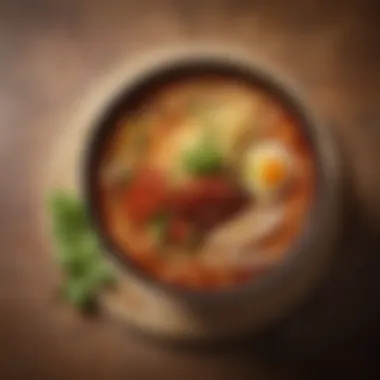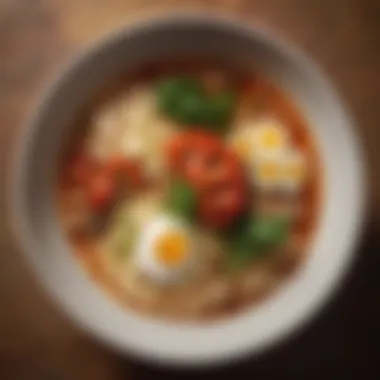Chili Tomato Ramen: A Culinary Exploration


Intro
Chili tomato ramen is more than a simple noodle dish; it is a synthesis of flavor and culture. This remarkable recipe combines robust tomatoes with the dynamic heat of chili peppers. The result is a dish that both warms and invigorates, appealing to taste buds from various culinary backgrounds. Understanding this dish involves delving into its ingredients, preparation styles, and the nutritional benefits it offers.
The modern food enthusiast seeks meals that are both satisfying and nourishing. Chili tomato ramen shines in this regard. Whether one is a seasoned home cook or a novice in the kitchen, mastering this recipe can contribute to a more diverse culinary repertoire.
As we explore the intricacies of chili tomato ramen, we will look at the essential components, preparation techniques, and regional variations. Ultimately, our goal is to inspire you to appreciate the delicate balance of flavors and textures found in this popular dish.
Recipe Overview
Recipe Name and Description
Chili Tomato Ramen is a spicy noodle soup that combines the acidity of fresh tomatoes with the warm heat of chilies. The dish is rich in flavor and has a vibrant appearance, making it a favorite among ramen lovers.
Cuisine Type
This dish falls under Japanese cuisine, with influences that can be seen in Asian cooking as a whole. It showcases how traditional ramen can be adapted to feature diverse ingredients, reflecting the evolving nature of food preparation.
Ingredients List
Detailed Ingredient Breakdown
To embark on your culinary journey, the following ingredients are essential for making chili tomato ramen:
- Ramen noodles: Different types can be used, such as fresh, dried, or instant.
- Tomatoes: Fresh tomatoes are preferred, but canned tomatoes can also work well.
- Chili peppers: Use your preferred type, whether it's jalapeño, serrano, or bird's eye.
- Garlic and ginger: Fresh garlic and ginger enhance the depth of flavor.
- Soy sauce: Contributes to the umami taste.
- Sesame oil: Adds richness; it can be used for sautéing.
- Broth: Chicken, beef, or vegetable broth may be used, depending on dietary preference.
- Green onions: For garnish and an added layer of flavor.
Substitutions for Dietary Needs
Observing dietary restrictions doesn’t mean sacrificing taste. Here are possible substitutions:
- For gluten-free options, use rice noodles instead of traditional ramen.
- If avoiding animal products, substitute with vegetable broth and coconut aminos instead of soy sauce.
- To reduce spice, use less chili pepper or try milder varieties.
- For those avoiding nightshades, consider using zoodles (zucchini noodles) with a stock that doesn't contain tomatoes.
The richness of chili tomato ramen lies in its versatility. By adjusting the ingredients, anyone can enjoy this dish tailored to their taste and dietary needs.
Intro to Chili Tomato Ramen
Chili tomato ramen represents a captivating fusion of flavors that intrigues many food enthusiasts. This dish signifies not only the merging of different culinary traditions but also the evolution of ramen itself. An essential consideration when exploring this dish is its ability to blend the spicy heat of chili with the rich, savory sweetness of tomatoes. This combination creates a complex palate experience, making it a favorite among various dining preferences.
The preparation of chili tomato ramen can serve as a doorway into the world of gastronomic creativity. At its core, this dish embodies both simplicity and sophistication, encouraging home cooks and professional chefs alike to experiment with their recipes. Utilizing straightforward ingredients, one can craft a bowl that is not only delicious but also visually appealing.
Beyond its taste, chili tomato ramen offers numerous benefits. It allows for customization based on dietary needs, with vegetarian and vegan options being particularly accesible. Additionally, the nutritional components of chili and tomatoes provide health advantages, making this dish a well-rounded choice for many.
In summary, this exploration into chili tomato ramen emphasizes its significance in modern cuisine. Understanding its ingredients and preparation methods enhances the cooking experience and enables a deeper appreciation of this culinary masterpiece.
Historical Context
Understanding the historical context of chili tomato ramen is essential for appreciating its evolution and significance in culinary traditions. This section delves into the origins of ramen, a dish that has transcended its simple beginnings to become a global phenomenon, blending with various ingredients and flavors.
Origins of Ramen


Ramen is widely recognized as a Japanese dish, but its roots can be traced back to China. Its journey began in the early 20th century when Chinese immigrants introduced wheat noodles in broth to Japan. The dish quickly gained popularity and was adapted to local tastes. By the 1930s, ramen began appearing in Japanese restaurants, and soon after, different styles emerged across the country. The ramen we know today is often categorized into major types, such as shoyu, miso, and tonkotsu. Each type showcases unique flavors that reflect regional preferences and influences. The addition of chili and tomato further diversified ramen's flavor profile, paving the way for a fusion that appeals to a wider audience.
Prelims of Chili and Tomato in Asian Cuisine
Chili and tomato both have fascinating histories within Asian cuisine. Chili, originally from the Americas, became popular in Asia during the 16th century, thanks to the Columbian Exchange. It found a permanent place in many Asian societies due to its ability to enhance flavor and provide heat. Countries like Thailand, India, and China have embraced chili in their culinary practices, giving rise to many regional dishes characterized by their spiciness.
Tomatoes, while originally from South America, made their way into Asian kitchens much later. By the 19th century, they were incorporated into various cooking styles across Asia. In countries such as China and India, tomatoes are now staples, often used in sauces and dishes that require acidity and sweetness.
When combined with ramen, the union of chili and tomato creates a rich, tangy, and spicy experience. This concoction is a testament to how traditional food practices can evolve and incorporate new elements, making them relevant in contemporary culinary landscapes.
In summary, the historical journey of chili tomato ramen reflects broader themes of cultural exchange and adaptation. These elements not only enrich the dish but also illustrate the dynamic nature of culinary traditions.
Essential Ingredients
The success of chili tomato ramen lies deeply within its essential ingredients. Each element contributes not only to the overall flavor profile but also to the texture and nutritional value of the dish. Understanding the selection and quality of these ingredients can elevate a simple bowl of ramen into a culinary experience. The following sections explore the key components that make up chili tomato ramen.
Noodles
Noodles serve as the foundation of any ramen dish. In the context of chili tomato ramen, the choice of noodles is critical. They should be firm enough to hold their texture even when soaked in flavorful broth. Common types used include wheat noodles, particularly those made from high-protein flour, which provides a satisfying chew. Some variants also include egg noodles, offering a richer taste.
When preparing the noodles, it is essential to cook them separately to the right al dente consistency. This ensures they remain pleasantly chewy when combined with the hot broth.
Broth
The broth is arguably the heart of chili tomato ramen. A well-prepared broth should have depth and richness while balancing the acidity of tomatoes and the heat from chili peppers. Common bases include chicken, pork, or vegetable broth. When crafting the broth, slow simmering allows the flavors to meld and intensify.
Adding components such as garlic, ginger, and onion can enhance the broth’s complexity. Additionally, incorporating spices can further tailor the flavor to achieve personal preferences.
Chili Peppers
Chili peppers are the defining ingredient that brings warmth and heat to the ramen. A variety of chili types can be selected, depending on the heat level desired. Some may prefer a milder jalapeño, while others might opt for spicy bird’s eye chilies.
Choosing fresh chili peppers allows for a more vibrant flavor compared to dried ones. The method of incorporation can also vary; some cooks may prefer slicing and adding them raw, while others may blend them into a paste to distribute their heat evenly throughout the broth.
Tomatoes
Tomatoes provide essential sweetness and acidity, balancing the richness of the broth. Fresh tomatoes can be roasted to enhance their natural sweetness before being added to the broth. Alternatively, canned tomatoes are a convenient option, often richer in flavor due to their preservation process. When choosing tomatoes, it is better to select ripe varieties to maximize flavor and depth.
Herbs and Spices
Herbs and spices add finishing touches to chili tomato ramen, enhancing its aroma and complexity. Commonly used herbs include cilantro and green onions, which provide freshness. Sesame oil or chili oil can also be drizzled on top for added depth.
Spices such as black pepper, paprika, or even a hint of cumin can further connect the ingredients while allowing personal creativity.
Preparation Techniques
Preparation techniques are a crucial part of making chili tomato ramen. They influence both the flavor profile and the overall satisfaction of the dish. Proper preparation allows one to unlock the full potential of the ingredients, creating layers of taste and texture. When each element is made with care and precision, it culminates in a harmonious and comforting meal. Understanding how to prepare each component ensures a satisfying experience, whether you are a novice in the kitchen or a seasoned cook.
Preparing the Broth
The broth is the backbone of any ramen dish, including chili tomato ramen. It can make or break the overall flavor. Starting with a good stock is essential. Common choices include chicken, pork, or vegetable stock. The key is to let it simmer for an extended period. Adding ingredients like garlic, ginger, and miso enhances the umami flavor.
For chili tomato ramen, introducing fresh tomatoes and chili paste or powder into the broth early in the cooking process helps to infuse a deep flavor. Additionally, using roasted tomatoes can introduce a more intense taste. Allow the broth to simmer for at least an hour to fully develop these flavors.
Cooking the Noodles
Noodle preparation is another integral step. Ramen noodles are often boiled until just al dente. Avoid overcooking them, as they will continue to cook when combined with the hot broth. Using high-quality fresh noodles will yield better results than instant varieties. Pay attention to timing; usually, 3–4 minutes in boiling water is sufficient for fresh noodles.


After cooking, it's a good practice to rinse them briefly in cold water. This stops the cooking process and prevents the noodles from sticking together.
Combining Ingredients
Once the broth and noodles are prepared, the next step is combining them. Pour the hot broth into a bowl and carefully place the noodles inside. The noodles should be submerged but not overly crowded. Each bowl can have its unique touch based on personal preference. You may choose to add prepped toppings like sliced green onions, soft boiled eggs, or even grilled pork.
Incorporating elements like tofu or leafy greens creates a more balanced dish. This step is where the individual flavors come to life and the dish starts to take shape.
Garnishing Techniques
Garnishing enhances visual appeal and introduces additional flavors. Opt for fresh herbs, such as cilantro or basil, to brighten the dish. Also, consider using sesame seeds for texture. A dash of chili oil can elevate the spiciness, appealing to those who prefer heat.
Lastly, consider the placement of your garnishes. A well-composed bowl of ramen looks inviting, encouraging others to dig in. It’s these small touches that can transform a simple dish into something extraordinary.
Variations of Chili Tomato Ramen
Variations of chili tomato ramen are significant in this culinary exploration, as they showcase the adaptability and versatility of this dish. This flexibility allows cooks to personalize their ramen experience while catering to diverse dietary preferences and cultural contexts. Each variation introduces unique ingredients and preparation methods, which enhances the overall appeal of chili tomato ramen.
Vegetarian and Vegan Options
For those who prefer plant-based diets, vegetarian and vegan options for chili tomato ramen can be equally satisfying as traditional versions. The core components, such as the noodles and broth, can be adjusted to exclude animal products without losing the dish's integrity.
The broth, typically made from pork or chicken, can be replaced by a robust vegetable stock. Incorporating earthy flavors from mushrooms or miso paste can deepen the taste profile.
Additionally, protein sources like tofu or tempeh serve as excellent stand-ins for meat. These options not only contribute texture but also add nutritional value.
When enhancing the dish, consider the following ingredients:
- Firm Tofu: Excellent for absorbing flavors and adding protein.
- Mushrooms: Shiitake or oyster mushrooms add umami and richness.
- Vegetables: Leafy greens, such as bok choy, and root vegetables introduce freshness and color.
A popular approach is to top the ramen with fresh herbs, like cilantro or green onions, providing a burst of flavor. The result is a delightful, spicy, and hearty meal that honors both the chili and tomato components while meeting vegetarian and vegan dietary needs.
Regional Takes on Chili Tomato Ramen
Regional adaptations of chili tomato ramen reflect local tastes and available ingredients. These variations not only enhance the dish but also highlight the cultural diversity surrounding ramen. In Southeast Asia, for instance, influences from local spices and cooking styles often shine through.
In Thailand, for example, the addition of lime and fresh herbs differentiates the dish. This version focuses on a balance of spicy, sour, and savory flavors. In contrast, a South Korean take might integrate gochujang, a fermented chili paste, which introduces a distinctive depth and complexity.
The blending of tradition with new elements encourages experimentation:
- Chinese Style: Often includes garlic and sesame oil, giving a fragrant twist.
- Japanese Style: May feature miso blended with tomato, producing a sweet and spicy fusion.
- Indian Style: Uses spices like cumin or coriander to elevate the heat and complexity.
These regional variations offer food lovers the opportunity to explore chili tomato ramen through a global lens, making each dining experience unique.
The exploration of local ingredients and techniques, along with the inherent flexibility of chili tomato ramen, ultimately nurtures culinary creativity. This is essential for anyone who wishes to expand their cooking repertoire.
Health Benefits
The significance of health benefits in the context of chili tomato ramen cannot be overstated. This dish, rich in flavors, also boasts a myriad of nutritional advantages. Understanding these benefits enriches one’s experience and appreciation of the meal. It serves as a reminder that one can indulge in delicious food while also being health-conscious.
Nutritional Components
Chili tomato ramen comprises several key ingredients, each contributing to its overall nutritional profile. Below are some of the primary components and their benefits:


- Noodles: Typically made from wheat, they provide carbohydrates for energy. Whole-grain options add fiber, promoting digestive health.
- Tomatoes: Rich in vitamins C and K, tomatoes also provide potassium and folate. Lycopene, an antioxidant found in tomatoes, has been linked to various health benefits, including reduced risk of certain cancers.
- Chilis: They contain capsaicin, which is known for its metabolism-boosting properties. Chilis also carry vitamin A, C, and B6, contributing to overall health.
- Broth: The base of the soup may incorporate various vegetables and seasonings, offering vitamins and minerals. Using bone broth, for example, can enhance collagen intake.
Each component works in tandem, making chili tomato ramen not only a satisfying dish but also a source of essential nutrients.
Impact of Chili and Tomato on Health
Both chili and tomato ingredients have been extensively studied for their health effects. Here are some key points to consider:
- Anti-Inflammatory Properties: The capsaicin in chili peppers is shown to exhibit anti-inflammatory effects, which can be beneficial for various health conditions.
- Heart Health: Tomatoes contribute to heart health due to their high levels of potassium and antioxidants. A diet rich in tomatoes is associated with lower blood pressure and heart disease risk.
- Weight Management: Consuming chilis may help in weight control. The heat can increase the feeling of fullness and boost metabolism, assisting those trying to manage their weight.
- Digestive Health: The fiber found in noodles and other components supports digestive function. Tomatoes also promote gut health due to their natural fibers and water content.
- Immune Support: Both chilis and tomatoes are high in vitamins that support the immune system, particularly vitamin C.
"Chili and tomato are not just flavor enhancers; they are powerful allies in promoting health and well-being."
In summary, the health benefits of chili tomato ramen extend beyond mere sustenance. By integrating rich nutritional content and beneficial properties, this dish presents an opportunity for individuals to embrace a delicious yet health-conscious lifestyle.
Cultural Significance
Chili tomato ramen stands not just as a meal but as an emblem of cultural fusion. Its existence reflects the convergence of culinary traditions, primarily from Japan and various regions where chili and tomatoes thrive. This ramen is a potent example of how food can transcend borders, bringing diverse flavors into harmony. The significance of chili tomato ramen in contemporary cuisine lies in its ability to adapt and evolve, showcasing the creativity and resourcefulness of chefs and home cooks alike.
Chili Tomato Ramen in Popular Culture
The rise of chili tomato ramen is notable in various aspects of popular culture. It appears in many culinary shows, cooking blogs, and social media platforms. Influencers and food enthusiasts often share their personal takes on this dish, showcasing unique recipes that introduce new ingredients and techniques while remaining true to the core elements of ramen. This phenomenon has established chili tomato ramen as not just food but a social experience.
Moreover, restaurants specializing in ramen have incorporated chili tomato variations on their menus. The fiery yet comforting blend attracts diners seeking excitement and warmth from their meals. The emotional connection people form around ramen sharing moments during meals or exploring different ramen eateries adds to its cultural weight.
Social Aspects of Ramen Consumption
Ramen is often more than sustenance; it fosters community. Eating chili tomato ramen, whether at home or in a restaurant, encourages gathering. Families often bond over a bowl, while friends celebrate accomplishments or provide comfort during tough times with a steaming hot serving. This communal aspect can deepen relationships and cultivate shared experiences.
Cultural practices surrounding ramen consumption can vary by region. In Japan, for instance, slurping noodles is seen as a compliment to the chef. In contrast, Western cultures might adopt fork use or a more subdued eating style. The growing trend of ramen bars and cooking classes also facilitates social interaction, creating spaces for individuals to learn and appreciate the nuances of chili tomato ramen together.
"Ramen is no longer just food; it’s a medium for connection and cultural exchange."
End
In the realm of culinary discussions, the exploration of chili tomato ramen holds much significance. It encompasses a wide array of flavors and cultural influences, which contribute to its growing popularity within various dining spaces. This section wraps up the key points discussed throughout the article, focusing on the dish's versatility, health benefits, and cultural relevance.
One of the most compelling aspects of chili tomato ramen is its adaptability. It accommodates various dietary preferences, making it a suitable choice for vegetarians, vegans, and meat lovers alike. The use of fresh ingredients not only adds depth but also ensures each bowl can be tailored according to one's palate. This makes chili tomato ramen an accessible dish for both novice cooks and seasoned chefs.
The nutritional benefits derived from the ingredients are another standout feature. Chili peppers offer potential metabolism-boosting properties, while tomatoes are rich in vitamins and antioxidants. Together, they create a dish that is both enjoyable to eat and beneficial for health. This dual appeal can enhance the dining experience, encouraging a more mindful approach to what we consume.
Moreover, chili tomato ramen's place in popular culture reflects its significance. As food enthusiasts continue to share their personal takes on this dish, it becomes not just a meal, but a symbol of creativity and community. Its presence in social media platforms and food blogs demonstrates a shared appreciation for culinary experimentation.
In summary, chili tomato ramen serves as a perfect fusion of flavor, nutrition, and cultural significance. For readers eager to expand their culinary skills, the exploration of this dish opens avenues for creativity and connection. Each bowl represents not just sustenance, but also a way to engage with diverse traditions in cooking.
Embracing dishes like chili tomato ramen can transform our kitchens into spaces of innovation and shared experiences, where food becomes a conduit for storytelling and exploration.
Final Thoughts on Chili Tomato Ramen
In reflecting on chili tomato ramen, it is clear that this dish warrants appreciation beyond its taste. The interplay of chili and tomato elevates the traditional ramen experience, offering warmth and comfort to those who prepare and enjoy it.
The preparation techniques detailed in the article allow for a deeper understanding of the dish. From broth to garnishing, each step has the potential to infuse creativity and personal touch. Food is not merely about consumption; it is about engagement with ingredients and the art of cooking itself.
For culinary enthusiasts, this exploration serves as a stepping stone into a world filled with culinary delights. As one experiments with flavors, the opportunity to embrace regional variations and personal preferences unfolds. Chili tomato ramen is not just a recipe; it is an invitation to embark on a flavorful journey, worthy of both an intimate meal and grand celebrations.
This dish encourages individuals to unite around a shared love for food, fostering connections through flavors that resonate with both familiarity and excitement. As such, chili tomato ramen is poised to maintain its place in the hearts and kitchens of food lovers everywhere.















